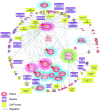Molecular and genomic approach for understanding the gene-environment interaction between Nrf2 deficiency and carcinogenic nickel-induced DNA damage
- PMID: 23023193
- PMCID: PMC3583472
- DOI: 10.3892/or.2012.2057
Molecular and genomic approach for understanding the gene-environment interaction between Nrf2 deficiency and carcinogenic nickel-induced DNA damage
Abstract
Nickel (Ⅱ) is a toxic and carcinogenic metal which induces a redox imbalance following oxidative stress. Nuclear factor erythroid-2 related factor 2 (Nrf2) is a redox factor that regulates oxidation/reduction status and consequently mediates cytoprotective responses against exposure to environmental toxicants. In this study, we investigated the protective roles of the Nrf2 gene against oxidative stress and DNA damage induced by nickel at sub-lethal doses. Under nickel exposure conditions, we detected significantly increased intracellular ROS generation, in addition to higher amounts of DNA damage using comet assay and γ-H2AX immunofluorescence staining in Nrf2 lacking cells, as compared to Nrf2 wild-type cells. In addition, we attempted to identify potential nickel and Nrf2-responsive targets and the relevant pathway. The genomic expression data were analyzed using microarray for the selection of synergistic effect-related genes by Nrf2 knockdown under nickel treatment. In particular, altered expressions of 6 upregulated genes (CAV1, FOSL2, MICA, PIM2, RUNX1 and SLC7A6) and 4 downregulated genes (APLP1, CLSPN, PCAF and PRAME) were confirmed by qRT-PCR. Additionally, using bioinformatics tool, we found that these genes functioned principally in a variety of molecular processes, including oxidative stress response, necrosis, DNA repair and cell survival. Thus, we describe the potential biomarkers regarded as molecular candidates for Nrf2-related cellular protection against nickel exposure. In conclusion, these findings indicate that Nrf2 is an important factor with a protective role in the suppression of mutagenicity and carcinogenicity by environmental nickel exposure in terms of gene-environment interaction.
Figures





Similar articles
-
Nuclear factor E2-related factor 2-dependent myocardiac cytoprotection against oxidative and electrophilic stress.Cardiovasc Toxicol. 2008 Summer;8(2):71-85. doi: 10.1007/s12012-008-9016-0. Epub 2008 May 8. Cardiovasc Toxicol. 2008. PMID: 18463988
-
The cytoprotective effect of butin against oxidative stress is mediated by the up-regulation of manganese superoxide dismutase expression through a PI3K/Akt/Nrf2-dependent pathway.J Cell Biochem. 2012 Jun;113(6):1987-97. doi: 10.1002/jcb.24068. J Cell Biochem. 2012. PMID: 22253095
-
Upregulation of nuclear factor (erythroid-derived 2)-like 2 protein level in the human colorectal adenocarcinoma cell line DLD-1 by a heterocyclic organobismuth(III) compound: Effect of organobismuth(III) compound on NRF2 signaling.Biomed Pharmacother. 2020 May;125:109928. doi: 10.1016/j.biopha.2020.109928. Epub 2020 Jan 28. Biomed Pharmacother. 2020. PMID: 32004978
-
Roles of NRF2 in DNA damage repair.Cell Oncol (Dordr). 2023 Dec;46(6):1577-1593. doi: 10.1007/s13402-023-00834-5. Epub 2023 Jun 26. Cell Oncol (Dordr). 2023. PMID: 37365451 Review.
-
Cytoprotection "gone astray": Nrf2 and its role in cancer.Onco Targets Ther. 2014 Aug 26;7:1497-518. doi: 10.2147/OTT.S36624. eCollection 2014. Onco Targets Ther. 2014. PMID: 25210464 Free PMC article. Review.
Cited by
-
Trolox contributes to Nrf2-mediated protection of human and murine primary alveolar type II cells from injury by cigarette smoke.Cell Death Dis. 2013 Apr 4;4(4):e573. doi: 10.1038/cddis.2013.96. Cell Death Dis. 2013. PMID: 23559007 Free PMC article.
-
Nickel Carcinogenesis Mechanism: DNA Damage.Int J Mol Sci. 2019 Sep 21;20(19):4690. doi: 10.3390/ijms20194690. Int J Mol Sci. 2019. PMID: 31546657 Free PMC article. Review.
-
Proteomic Assessment of Biochemical Pathways That Are Critical to Nickel-Induced Toxicity Responses in Human Epithelial Cells.PLoS One. 2016 Sep 14;11(9):e0162522. doi: 10.1371/journal.pone.0162522. eCollection 2016. PLoS One. 2016. PMID: 27626938 Free PMC article.
-
Human AP endonuclease 1: a potential marker for the prediction of environmental carcinogenesis risk.Oxid Med Cell Longev. 2014;2014:730301. doi: 10.1155/2014/730301. Epub 2014 Aug 26. Oxid Med Cell Longev. 2014. PMID: 25243052 Free PMC article. Review.
-
Heavy Metal Exposure-induced Cardiovascular Diseases: Molecular Mechanisms and Therapeutic Role of Antioxidants.Curr Med Chem. 2025;32(17):3438-3465. doi: 10.2174/0109298673307446240514064253. Curr Med Chem. 2025. PMID: 38757322 Review.
References
-
- Kasprzak KS, Sunderman FW, Jr, Salnikow K. Nickel carcinogenesis. Mutat Res. 2003;533:67–97. - PubMed
-
- Kasprzak KS. Possible role of oxidative damage in metal-induced carcinogenesis. Cancer Invest. 1995;13:411–430. - PubMed
-
- Lynn S, Yew FH, Chen KS, Jan KY. Reactive oxygen species are involved in nickel inhibition of DNA repair. Environ Mol Mutagen. 1997;29:208–216. - PubMed
-
- Aust AE, Eveleigh JF. Mechanisms of DNA oxidation. Proc Soc Exp Biol Med. 1999;222:246–252. - PubMed
-
- Chakrabarti SK, Bai C, Subramanian KS. DNA-protein crosslinks induced by nickel compounds in isolated rat lymphocytes: role of reactive oxygen species and specific amino acids. Toxicol Appl Pharmacol. 2001;170:153–165. - PubMed
Publication types
MeSH terms
Substances
LinkOut - more resources
Full Text Sources
Miscellaneous

